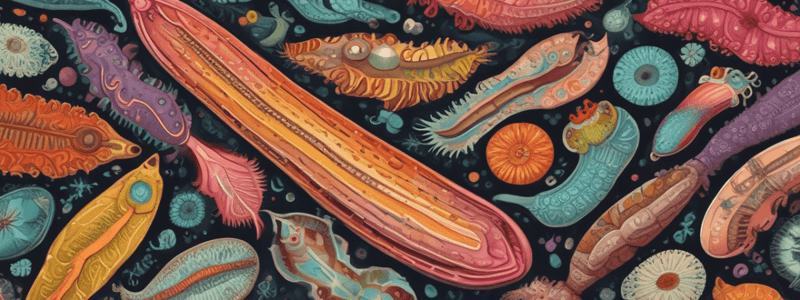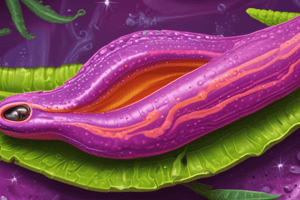Podcast
Questions and Answers
Which of the following is true about the life cycle of Myxozoa?
Which of the following is true about the life cycle of Myxozoa?
- They have a three-host life cycle.
- They have a direct life cycle, without any intermediate hosts.
- They have a single host life cycle.
- They have a two-host life cycle, with different spore forms produced. (correct)
What is the relationship between Myxozoa and the phylum Cnidaria?
What is the relationship between Myxozoa and the phylum Cnidaria?
- Myxozoa are a class within the phylum Cnidaria.
- Myxozoa and Cnidaria are both parasitic groups, but they are not closely related.
- Myxozoa were previously classified as protozoans, but are now known to be parasitic jellyfish within Cnidaria. (correct)
- Myxozoa are a separate phylum, unrelated to Cnidaria.
What is the primary function of the polar capsules in Myxozoa?
What is the primary function of the polar capsules in Myxozoa?
- To help infect a new host by penetrating the host's tissues. (correct)
- To produce spores for reproduction.
- To inject toxins into the host.
- To help the parasite attach to the host.
Which of the following is a key characteristic of the class Monogenea?
Which of the following is a key characteristic of the class Monogenea?
Which of the following is a known effect of Kudoa species on human health?
Which of the following is a known effect of Kudoa species on human health?
Which phylum includes thorny-headed worms?
Which phylum includes thorny-headed worms?
What is the class of ectoparasitic flatworms that are especially found on the skin, fins, and gills of fish?
What is the class of ectoparasitic flatworms that are especially found on the skin, fins, and gills of fish?
Which of the following is a characteristic of Class Monogenea?
Which of the following is a characteristic of Class Monogenea?
Where are thorny-headed worms most commonly found in their hosts?
Where are thorny-headed worms most commonly found in their hosts?
Which phylum includes free-living flatworms, some of which have parasitic forms?
Which phylum includes free-living flatworms, some of which have parasitic forms?
What is a key characteristic of Monogenea based on the text?
What is a key characteristic of Monogenea based on the text?
Which of the following is true about Gyrodactylus?
Which of the following is true about Gyrodactylus?
What sets Monogenea apart from other flatworms according to the text?
What sets Monogenea apart from other flatworms according to the text?
Which of the following is NOT a characteristic of Monogenea as discussed in the text?
Which of the following is NOT a characteristic of Monogenea as discussed in the text?
What is the distinguishing characteristic of Phylum Acanthocephala?
What is the distinguishing characteristic of Phylum Acanthocephala?
Which class includes the tapeworms among the flatworms?
Which class includes the tapeworms among the flatworms?
Class Monogenea is known for parasitizing the skin of hosts, earning them the name __________
Class Monogenea is known for parasitizing the skin of hosts, earning them the name __________
What is a notable fact about Myxozoa?
What is a notable fact about Myxozoa?
Which of the following statements about the life cycle of Acanthocephala (thorny-headed worms) is correct?
Which of the following statements about the life cycle of Acanthocephala (thorny-headed worms) is correct?
Which of the following hosts can Acanthocephala infect?
Which of the following hosts can Acanthocephala infect?
What stage of the Acanthocephala life cycle was observed in the unusual cysts found in the skeletal muscle of mongooses and monkeys?
What stage of the Acanthocephala life cycle was observed in the unusual cysts found in the skeletal muscle of mongooses and monkeys?
How is the presence of Acanthocephala typically diagnosed?
How is the presence of Acanthocephala typically diagnosed?
What is the key feature of the life cycle of the myxozoan parasite Myxobolus cerebralis that causes whirling disease in salmonid fish?
What is the key feature of the life cycle of the myxozoan parasite Myxobolus cerebralis that causes whirling disease in salmonid fish?
What is the significance of the 'Polar capsule/filaments' mentioned in the text?
What is the significance of the 'Polar capsule/filaments' mentioned in the text?
How are Myxozoa classified in relation to the phylum Cnidaria?
How are Myxozoa classified in relation to the phylum Cnidaria?
What is the characteristic behavior exhibited by salmonid fish infected with Myxobolus cerebralis?
What is the characteristic behavior exhibited by salmonid fish infected with Myxobolus cerebralis?
What is the primary reason for the spread of Myxobolus cerebralis, the causative agent of whirling disease, to new regions?
What is the primary reason for the spread of Myxobolus cerebralis, the causative agent of whirling disease, to new regions?
Which of the following groups of animals are known to be infected by myxospores from the hepatic biliary group of myxosporeans?
Which of the following groups of animals are known to be infected by myxospores from the hepatic biliary group of myxosporeans?
Which of the following statements about myxospores is true?
Which of the following statements about myxospores is true?
Which of the following groups of fish is known to be infected by myxosporeans in the urinary system?
Which of the following groups of fish is known to be infected by myxosporeans in the urinary system?
Which of the following statements about Tetracapsuloides bryosalmonae is true?
Which of the following statements about Tetracapsuloides bryosalmonae is true?
Which of the following factors contributed to the collapse of the arctic char population in Iceland due to Tetracapsuloides bryosalmonae infection?
Which of the following factors contributed to the collapse of the arctic char population in Iceland due to Tetracapsuloides bryosalmonae infection?
Which of the following is a key characteristic of the class Monogenea?
Which of the following is a key characteristic of the class Monogenea?
Which of the following phyla is known for its members having cnidocytes (stinging cells)?
Which of the following phyla is known for its members having cnidocytes (stinging cells)?
Which of the following statements about the phylum Myxozoa is true?
Which of the following statements about the phylum Myxozoa is true?
Flashcards are hidden until you start studying
Study Notes
Helminths: Parasitic Worms
- Helminths are large and multicellular, including several phyla that are unrelated but have superficial similarities.
- They are vermiform or "worm-like" in form.
Phyla and Classes
- Phylum Nematoda (roundworms)
- Phylum Platyhelminthes (flatworms)
- Class Cestoda (tapeworms)
- Class Trematoda (flukes: endoparasites)
- Class Monogenea (skin flukes: ectoparasites)
- Class Turbellaria (free-living flatworms, some parasitic forms)
- Phylum Acanthocephala (thorny-headed worms)
- Phylum Annelida (segmented worms) not parasitic (leeches)
Acanthocephala: Thorny-Headed Worms
- Acanthocephalans are highly adapted parasites that have lost many organs and structures through evolutionary processes.
- They are vermiform or "worm-like" in form.
- The earliest recognisable description of Acanthocephala was made by Italian author Francesco Redi in 1684.
- Recent genomic data suggests that Acanthocephala are a sister group to rotifers: freshwater zooplankton.
- Invertebrate intermediate host, adult stage almost always in the digestive tract, not usually pathogenic.
- Acanthocephalans are sexually dioecious (an individual organism is either male or female).
- All have complex life cycles, many are not host-specific, and they infect invertebrates, birds, amphibians, fish, and mammals.
- Diagnosis is by observation of eggs in feces.
Monogenea: Ectoparasitic Flatworms
- Part of the Phylum Platyhelminthes
- Ectoparasites: especially on the skin, fins, and gills of fish, also in exotics like frogs, reptiles, and hippos (in the eye)
- No true body cavity or coelom
- Can be quite large (2-3 cm) or microscopic (e.g., Gyrodactylus)
- Simple digestive system: mouth, pharynx, and intestine, no anus (flame cells are specialized excretory cells found in the simplest freshwater invertebrates, including flatworms)
- Poorly developed suckers, attachment is via hooks (classification)
- Hermaphroditic, mostly producing eggs, some are viviparous
- Ancestrally related to Turbellaria (free-living flatworms) and closest to modern cestodes
Myxozoa: Parasitic Jellyfish (Cnidaria)
- Obligate parasites with a two-host life cycle, producing two different spore forms.
- All have polar capsules, which are used to help infect a new host, related to the stinging cells (nematocysts) in non-parasitic Cnidaria.
- Some cause very serious diseases in commercial fish species, both farmed and wild.
- Problematic species are typically histozoic, being found inside host tissues.
- Coelozoic forms are generally not pathogenic, just interesting.
- They also infect some birds, amphibians, reptiles, and mammals.
- Some species of Kudoa are known to cause human gastrointestinal problems when eaten in undercooked fish.
Myxosporea: Class of Myxozoa
- Phylum Cnidaria
- Myxosporea are highly adapted parasitic cnidarians.
- Indirect life cycle: fish host, myxospore, actinospore, annelid host (oligochaete / polychaete).
- Examples: Myxobolus cerebralis and whirling disease, Hepatic biliary group of myxosporeans.
Tetracapsuloides bryosalmonae: A Myxozoan Parasite
- Causes Proliferative Kidney Disease (PKD), one of the most serious parasitic diseases of salmonid populations in Europe and North America.
- Collapse of arctic char population in Iceland due to this parasite, as water temperatures have risen about 1°C, and the parasite becomes pathogenic.
Studying That Suits You
Use AI to generate personalized quizzes and flashcards to suit your learning preferences.




